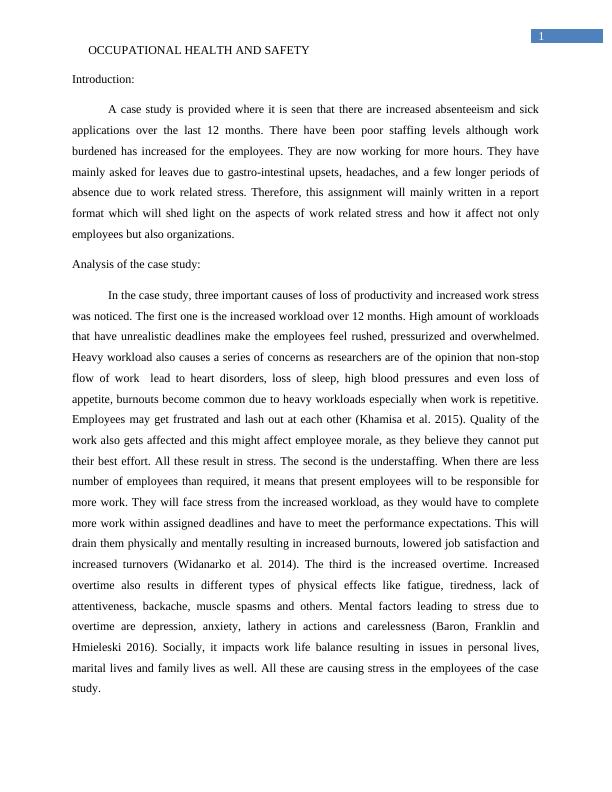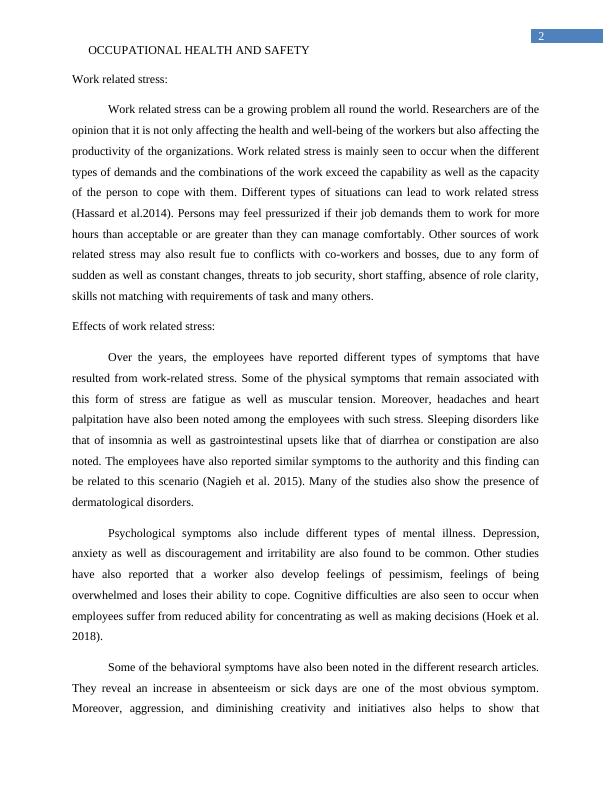Work Related Stress and Its Impact on Employees and Organizations
Added on 2023-06-09
10 Pages3242 Words379 Views
Running head: OCCUPATIONAL HEALTH AND SAFETY
OCCUPATIONAL HEALTH AND SAFETY
Name of the student:
Name of the university:
Author note:
OCCUPATIONAL HEALTH AND SAFETY
Name of the student:
Name of the university:
Author note:

1
OCCUPATIONAL HEALTH AND SAFETY
Introduction:
A case study is provided where it is seen that there are increased absenteeism and sick
applications over the last 12 months. There have been poor staffing levels although work
burdened has increased for the employees. They are now working for more hours. They have
mainly asked for leaves due to gastro-intestinal upsets, headaches, and a few longer periods of
absence due to work related stress. Therefore, this assignment will mainly written in a report
format which will shed light on the aspects of work related stress and how it affect not only
employees but also organizations.
Analysis of the case study:
In the case study, three important causes of loss of productivity and increased work stress
was noticed. The first one is the increased workload over 12 months. High amount of workloads
that have unrealistic deadlines make the employees feel rushed, pressurized and overwhelmed.
Heavy workload also causes a series of concerns as researchers are of the opinion that non-stop
flow of work lead to heart disorders, loss of sleep, high blood pressures and even loss of
appetite, burnouts become common due to heavy workloads especially when work is repetitive.
Employees may get frustrated and lash out at each other (Khamisa et al. 2015). Quality of the
work also gets affected and this might affect employee morale, as they believe they cannot put
their best effort. All these result in stress. The second is the understaffing. When there are less
number of employees than required, it means that present employees will to be responsible for
more work. They will face stress from the increased workload, as they would have to complete
more work within assigned deadlines and have to meet the performance expectations. This will
drain them physically and mentally resulting in increased burnouts, lowered job satisfaction and
increased turnovers (Widanarko et al. 2014). The third is the increased overtime. Increased
overtime also results in different types of physical effects like fatigue, tiredness, lack of
attentiveness, backache, muscle spasms and others. Mental factors leading to stress due to
overtime are depression, anxiety, lathery in actions and carelessness (Baron, Franklin and
Hmieleski 2016). Socially, it impacts work life balance resulting in issues in personal lives,
marital lives and family lives as well. All these are causing stress in the employees of the case
study.
OCCUPATIONAL HEALTH AND SAFETY
Introduction:
A case study is provided where it is seen that there are increased absenteeism and sick
applications over the last 12 months. There have been poor staffing levels although work
burdened has increased for the employees. They are now working for more hours. They have
mainly asked for leaves due to gastro-intestinal upsets, headaches, and a few longer periods of
absence due to work related stress. Therefore, this assignment will mainly written in a report
format which will shed light on the aspects of work related stress and how it affect not only
employees but also organizations.
Analysis of the case study:
In the case study, three important causes of loss of productivity and increased work stress
was noticed. The first one is the increased workload over 12 months. High amount of workloads
that have unrealistic deadlines make the employees feel rushed, pressurized and overwhelmed.
Heavy workload also causes a series of concerns as researchers are of the opinion that non-stop
flow of work lead to heart disorders, loss of sleep, high blood pressures and even loss of
appetite, burnouts become common due to heavy workloads especially when work is repetitive.
Employees may get frustrated and lash out at each other (Khamisa et al. 2015). Quality of the
work also gets affected and this might affect employee morale, as they believe they cannot put
their best effort. All these result in stress. The second is the understaffing. When there are less
number of employees than required, it means that present employees will to be responsible for
more work. They will face stress from the increased workload, as they would have to complete
more work within assigned deadlines and have to meet the performance expectations. This will
drain them physically and mentally resulting in increased burnouts, lowered job satisfaction and
increased turnovers (Widanarko et al. 2014). The third is the increased overtime. Increased
overtime also results in different types of physical effects like fatigue, tiredness, lack of
attentiveness, backache, muscle spasms and others. Mental factors leading to stress due to
overtime are depression, anxiety, lathery in actions and carelessness (Baron, Franklin and
Hmieleski 2016). Socially, it impacts work life balance resulting in issues in personal lives,
marital lives and family lives as well. All these are causing stress in the employees of the case
study.

2
OCCUPATIONAL HEALTH AND SAFETY
Work related stress:
Work related stress can be a growing problem all round the world. Researchers are of the
opinion that it is not only affecting the health and well-being of the workers but also affecting the
productivity of the organizations. Work related stress is mainly seen to occur when the different
types of demands and the combinations of the work exceed the capability as well as the capacity
of the person to cope with them. Different types of situations can lead to work related stress
(Hassard et al.2014). Persons may feel pressurized if their job demands them to work for more
hours than acceptable or are greater than they can manage comfortably. Other sources of work
related stress may also result fue to conflicts with co-workers and bosses, due to any form of
sudden as well as constant changes, threats to job security, short staffing, absence of role clarity,
skills not matching with requirements of task and many others.
Effects of work related stress:
Over the years, the employees have reported different types of symptoms that have
resulted from work-related stress. Some of the physical symptoms that remain associated with
this form of stress are fatigue as well as muscular tension. Moreover, headaches and heart
palpitation have also been noted among the employees with such stress. Sleeping disorders like
that of insomnia as well as gastrointestinal upsets like that of diarrhea or constipation are also
noted. The employees have also reported similar symptoms to the authority and this finding can
be related to this scenario (Nagieh et al. 2015). Many of the studies also show the presence of
dermatological disorders.
Psychological symptoms also include different types of mental illness. Depression,
anxiety as well as discouragement and irritability are also found to be common. Other studies
have also reported that a worker also develop feelings of pessimism, feelings of being
overwhelmed and loses their ability to cope. Cognitive difficulties are also seen to occur when
employees suffer from reduced ability for concentrating as well as making decisions (Hoek et al.
2018).
Some of the behavioral symptoms have also been noted in the different research articles.
They reveal an increase in absenteeism or sick days are one of the most obvious symptom.
Moreover, aggression, and diminishing creativity and initiatives also helps to show that
OCCUPATIONAL HEALTH AND SAFETY
Work related stress:
Work related stress can be a growing problem all round the world. Researchers are of the
opinion that it is not only affecting the health and well-being of the workers but also affecting the
productivity of the organizations. Work related stress is mainly seen to occur when the different
types of demands and the combinations of the work exceed the capability as well as the capacity
of the person to cope with them. Different types of situations can lead to work related stress
(Hassard et al.2014). Persons may feel pressurized if their job demands them to work for more
hours than acceptable or are greater than they can manage comfortably. Other sources of work
related stress may also result fue to conflicts with co-workers and bosses, due to any form of
sudden as well as constant changes, threats to job security, short staffing, absence of role clarity,
skills not matching with requirements of task and many others.
Effects of work related stress:
Over the years, the employees have reported different types of symptoms that have
resulted from work-related stress. Some of the physical symptoms that remain associated with
this form of stress are fatigue as well as muscular tension. Moreover, headaches and heart
palpitation have also been noted among the employees with such stress. Sleeping disorders like
that of insomnia as well as gastrointestinal upsets like that of diarrhea or constipation are also
noted. The employees have also reported similar symptoms to the authority and this finding can
be related to this scenario (Nagieh et al. 2015). Many of the studies also show the presence of
dermatological disorders.
Psychological symptoms also include different types of mental illness. Depression,
anxiety as well as discouragement and irritability are also found to be common. Other studies
have also reported that a worker also develop feelings of pessimism, feelings of being
overwhelmed and loses their ability to cope. Cognitive difficulties are also seen to occur when
employees suffer from reduced ability for concentrating as well as making decisions (Hoek et al.
2018).
Some of the behavioral symptoms have also been noted in the different research articles.
They reveal an increase in absenteeism or sick days are one of the most obvious symptom.
Moreover, aggression, and diminishing creativity and initiatives also helps to show that

End of preview
Want to access all the pages? Upload your documents or become a member.
Related Documents
Occupation Health and Safetylg...
|4
|525
|207
Strategies to Overcome Nurse Fatigue and Stress Due to Long Working Hourslg...
|15
|3977
|288
Legal Professional Issues in Nursing: Impact of Nurse Workload on Patient Safety and Strategies for Workload Managementlg...
|10
|2638
|209
Inquiry Based Learning: Stressful Workplacelg...
|8
|2580
|27
Nursing Leadership Report 2022lg...
|11
|2805
|20
National Institute for Occupational Safety & Healthlg...
|3
|413
|14